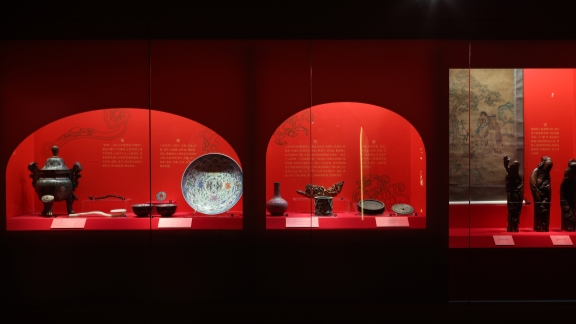

Ancient auspicious culture exhibition in Shanghai highlights tranquility, joy

The "Tranquility and Joy: Ancient Auspicious Culture Exhibition" opened at the Shanghai History Museum in Huangpu District on Wednesday.

The exhibition highlights different "auspicious" culture.
Jixiang (literally translated into auspicious) culture, a key part of traditional Chinese culture, embodies ancient people's observations of life and their aspirations.
On Wednesday, the "Tranquility and Joy: Ancient Auspicious Culture Exhibition" opened at the Shanghai History Museum in Huangpu District.
The exhibition presents 131 precious artifacts from the Tianjin Museum, including ceramics, jade, textiles, and paintings, showcasing ancient people's reverence for life through diverse art and craftsmanship.
Jointly hosted by the Shanghai History Museum and Tianjin Museum, the show is divided into five sections:"Happiness," "Prosperity," "Longevity," "Joy" and "Wealth," each highlighting different aspects of people's hopes in ancient auspicious culture.

A glimpse into the exhibition.
"Happiness" represents the richest and most typical auspicious meanings, while "Prosperity" reflects the longing for a high social status and carefree life. "Longevity" symbolizes the appreciation for life, "Joy" captures life's beautiful moments, especially happy marriages, and "Wealth" shows the desire for abundance through personal effort and divine protection, allowing viewers to intuitively understand the spiritual world of the ancients through auspicious shapes and patterns.
A Qing Dynasty (1644-1911) cloisonne baoxiang flower-patterned box is on display. Baoxiang flower, often featuring peonies or lotuses with flower leaves and bead-like centers, symbolizes auspiciousness and has been widely used for decoration since the Tang Dynasty (AD 618-907).

A Qing Dynasty (1644-1911) vase
A Qing Dynasty bottle features the pattern of Liu Hai playing with a golden toad, illustrating the pursuit of "wealth." Liu Hai, a Taoist figure, is said to have tamed a golden toad that spits money to help the poor, making it a symbol of wealth and good fortune.
The qilin, like dragons and phoenixes, is a mythical creature created by ancient people for a better life, symbolizing auspiciousness, while the elephant is regarded as an auspicious animal, often depicted carrying a treasure bottle (homophonic for peace).
A Ming Dynasty (1368-1644) blue-glazed white qilin and elephant-patterned censer and a Qing Dynasty red silk elephant-patterned chair cover are also displayed.

A Qing Dynasty cloisonne baoxiang flower-patterned box

A chair cover dating back to the Qing Dynasty

A mirror from the Qing Dynasty
If you go
Date: 9am-5pm, through June 2
Venue: Shanghai History Museum
Address: 325 Nanjing Rd W. 南京西路325号
Admission: Free
